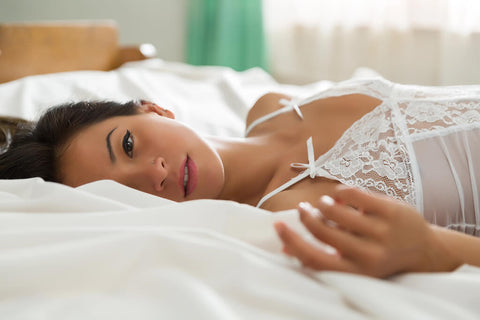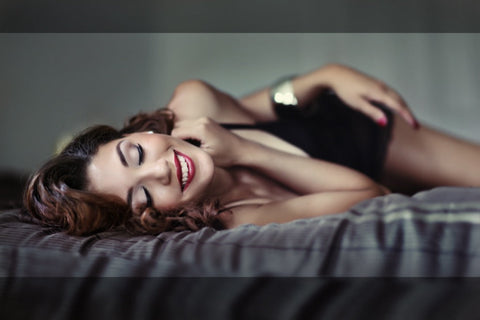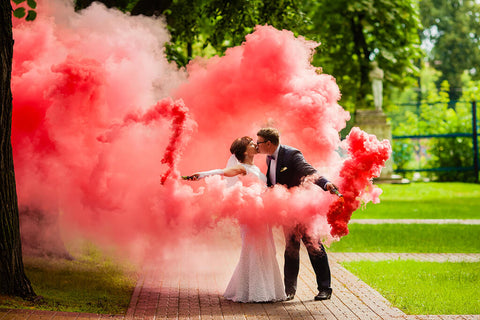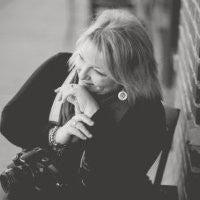- Lightroom Presets
- Mobile Presets
-
Photoshop
-
Learn
-
Support
-
Install
- Best Sellers
- Blog
By Tina Auten on | No Comments

I see this question asked frequently in photography groups and have noticed the topic is quite often debated with great passion between photographers who champion their favorite lens. In these debates “lens distortion” is often cited as a common reason to avoid a wide angle lens in favor of a longer telephoto lens.
In order to discuss which focal length is best for portraits, it is important to first define lens distortion and perspective distortion to see how it impacts portraits.
This term is also referred to as optical distortion and almost all lenses have some degree of optical distortion. When reviewing the specs of any particular lens, look for "barrel distortion" and you will see a small number such as 1.4% - this is the amount of optical distortion that will occur using that lens to shoot an image in a horizontal (landscape) position.
In short, the barrel of the lens is rounded and when looking at images, the center of the photograph will seem to come forward in a slightly rounded fashion with the rest of the image falling into the corners of the frame (sometimes it looks like light vignetting). This effect is generally more pronounced when using a wide angle lens.

For those of you who routinely use the “enable lens correction” feature in Lightroom, you might notice how the image can appear to flatten in the middle and the corners tend to smooth out. When you use this, you are correcting the optical distortion of your lens. In the example below, I was shooting a landscape using a 16-35mm 2.8L lens and was at the widest point - 16mm.
Look at the bridge in the center of the "before image" below and also take note of the darkened corners. Once the enable lens profile correction was clicked in Lightroom, the corners were smoothed out and there was not too much distortion in the middle. It is still there, but very subtle.
Try using the Lightroom lens correction feature on some of your own photos and click back and forth to see what this tool does for your images.

In this next example below, it is easy to assume optical distortion has made the hands larger than what they are in relation to the body but in reality, what you are seeing is called perspective distortion and this occurs when the subject is too close to the camera.
Perspective distortion is usually what photographers mean when they talk about lens distortion in portraits taken with a wide angle lens because facial features, such as the nose, can look more prominent when photographing too close to the subject.
In this image, I wanted the focus to be on the slug held tenderly by my grandson and I was shooting with the Sigma Art 35mm 1.4 which has a very short minimum focusing distance (just under 12”) while using a wide aperture (f/2.2). His hands and the slug look a bit disproportionate to the rest of his body because I was so close, but I think it works as a lifestyle image that documents a moment of childhood fun.

You can easily avoid perspective distortion by moving your subject away from the camera as in the next two examples. Both of these photographs were also shot with the Sigma Art 35mm 1.4.
In the first example, I took advantage of the shorter minimum focusing distance and was very close to my grandson who was giving me his “serious” look. Aside from a slightly bored expression, look how large his face is in comparison to his shoulders. Also, his nose seems just a tiny bit too big for his face.
However, by simply backing up a few more steps I put enough distance in between the camera and my subject so that his body has a better proportion. His arms do look a tiny bit distorted due to being the closest part of his body to the camera, but his head, shoulders and facial features are much more normal looking to the human eye.

Now that we have discussed the differences between optical distortion and perspective distortion, let’s talk focal length. There are many photographers who will argue that longer focal lengths will prevent perspective distortion; particularly in portraits.
In general, your focal length does not affect the perspective of a subject but instead affects how tight (or close) a subject will appear in your frame. Remember, a shorter lens allows more of the scene into the frame while a longer lens allows less but will bring your subject closer to you.
In the examples below, I was standing approximately 5 feet from my coffee cup and while a tripod would have been more scientific, there's a counter behind me that doesn’t move so I knew I was standing the maximum distance away from my cup each time (and I left the coffee cup in place). In addition to standing in the same place and not touching the cup, I shot each image at 2.2 - placing the focus point in the center of the word “photographer,” and none of the frames have been cropped.
I did, however, use the Auto Transform adjustment tool so that the mug is level in each frame. Look closely and you will notice the perspective of the mug remains consistent between each lens. This is because the focal length does not impact perspective distortion when you are far enough away from your subject.

In this next series, I once again used a Sigma Art 35mm 1.4, Canon 85mm 1.8 and a Sigma Art 135mm 1.8 set on f/2.2. My goal was to get as close as possible to my subject to get a tight headshot with each lens. While the basic composition remains consistent (a bit of shoulders showing with the emphasis on my subject's face), you can definitely see two things:
The perspective distortion was caused by the distance between my camera and her face rather than the focal length. My measurements were approximate due to being my own photo assistant, but the first image I was approximately 29” away from my model using the 35mm. Backing up, I was at approximately 52” with the 85mm and backed up to almost 104” in order to use the 135mm on a tight headshot.
For those who primarily use wider focal lengths, the distance might feel awkward and uncomfortable at first but I can assure you, the results can be stunning once you get used to backing up that extra few feet!

In this last series, I stepped even further back with each lens to try to eliminate any possible perspective distortion.
The 35mm image was shot approximately 64” from my subject (for environmental portraits, this is a great choice for showcasing a subject within the context of a specific location).
For example, if I was going to do a portrait of a bartender making a cocktail, the 35mm would allow me to get close enough to capture the action while showing enough of the bar in the background to provide contextual clues to the viewer.
This is also why the 35mm is the lens of choice for many lifestyle photographers. With it's wide aperture, it is versatile in small spaces and does a great job of isolating a subject while still allowing enough background into the frame for great storytelling.
With the 85mm, I was just over 81” away from my subject and could have backed up, even more, to get a “waist up” portrait. Still, at 2.2, notice how creamy the background is compared to the 35mm.
The 85mm is considered a workhorse among portrait photographers and as a medium telephoto lens, it is extremely versatile. It is long enough to get a beautiful bokeh background but short enough that you don’t feel so far away from your subject(s). Depending on space available, this lens can be used indoors and I like it very much for detail shots or for hanging back a bit during a lifestyle session so my subjects can forget my presence.
Lastly, using the 135mm lens, I was approximately 164” away from my subject. Yes, that is over 13 feet away from my subject just to get her from the waist up, but I simply love that gorgeous background behind her. Yes, it takes more physical work on your part to run back and forth when shooting with a prime lens of this length but the results can be worth the tradeoff in cardio activity!
I use my 135mm lens quite often, shooting everything from my grandson’s swim meets to portrait clients. It is also a terrific lens to have on hand for wedding work because you can be very discreet, shooting from a distance while still capturing intimate moments in each frame.

The biggest thing to remember about a longer focal length is that you will need plenty of space to back up so you can compose your shot as desired. Sometimes, the background won’t matter much but other times, you will want to include it as part of the story.
Well, that depends. When choosing a lens for a particular shoot, these are a few things you need to consider:

You will find there are certain favorite lenses used by photographers but my best advice is to rent the lenses that interest you and try them out first. A new lens can be similar to a new relationship - it might take more than one date to see it’s beauty and get to know it.
I have also found that my taste in lenses has changed as I have grown my technical and artistic photography skills. Currently, the three lenses I used in conjunction with photographing for this article are the my workhorses and I love each of them for different reasons.
I hope this article helps you understand that most any lens can be used for portraits, you just have to make sure you know how to use them.
Here is a great focal length cheat sheet to help you choose a lens depending on your location, genre, and shooting style. Feel free to print it out, or even share on your website (see below)!

Do you have any questions or comments about Which Focal Length is Best for Portraits? Just leave us a comment below - we would LOVE to hear from you! And PLEASE SHARE this post using the social sharing buttons (we really appreciate it)!




Tina is a Texas girl who is passionate about family, Friday nights under the lights, Mexican food, sunrise sessions on the beach, cold beer, and all things related to photography. Married for nearly 30 years to her best friend, they enjoyed life as an Air Force family while raising three children: Taryn (angel at 19), Bethany (28), Creighton (24), and grandparents to Caleb. Tina has the heart of a student and teacher, so she’s always eager to learn (and master) new interests and then share that knowledge with others. She is a natural light and lifestyle photographer in Southlake, Texas.

Comments